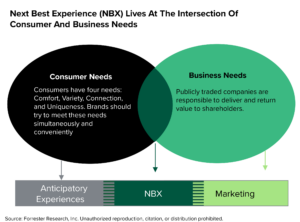Anticipate Your Customers’ Next Best Experiences
We asked more than 60 executive digital leaders about anticipatory experiences: They all agreed that “anticipating the needs of our customers and serving them proactively will create value for our customers and give us a competitive advantage.” Delivering anticipatory experiences demands two core competencies:
- Anticipating the need of the consumer. Some customer journeys are well understood. Brands know when to engage consumers and how. In more advanced scenarios, enterprises must either watch and listen very closely or use machine learning to anticipate the needs of their customers.
- Proactively serving that customer in that moment by quickly and dynamically assembling the content, identifying the recipient, deciding when to engage the recipient, and then where — i.e., what channel (SMS, browser, app, etc.).
Customer analytics assists with both core competencies. Each interaction with customers creates a trail of data that businesses should analyze to determine what customers want and need. There are several analytical techniques that companies can use to separate the signals from the noise. But a profusion of signals creates its own layer of noise. The question then becomes: Given all these great signals, what should we do next with the customer?
Enter The Next Best Experience (NBX)
NBX is an analytical paradigm that enables companies to identify and deliver the right experience to the right customer in real time based on everything they know about the customer. It takes signals gleaned from various customer analytics techniques to recommend action in the context of a customer journey, independent of business domain. This can manifest in many ways:
- The experience could be customer service, customer engagement, or an operational, product, financial, sales, or marketing experience.
- These experiences might appear to the consumer as a text message, pop up on a website or mobile app, or even manifest in a connected product.
- NBX may recommend no action at all, if that’s in the best interest of the long-term customer relationship.
How Can A Company Determine What The Next Best Experience Is?
The next best experience could be anticipatory, but it could also be reactive based on what the analytics deem is “best.” Of course, “best” is a loaded term and open to interpretation.
- Most companies that are focused on maximizing profit and therefore shareholder return will eventually use customer lifetime value (CLV) as the common currency across business domains to determine which candidate experience is optimal. CLV predicts the future profitability of a customer relationship and has both a monetary value and loyalty component. So in some cases, a business may forego a short-term revenue win and invest in building customer loyalty and therefore CLV.
- Other organizations may not be interested in optimizing for lifetime value. Healthcare providers, utilities, and the government, for example, are often more interested in reducing operating costs than driving top-line growth.
- Other organizations may have a triple bottom line and therefore will need to balance economic impact with environmental and social impact, as well. Some mission-driven credit unions try to determine next best experience by balancing CLV with value for members (customers).
No matter which definition of “best” your company lands on, the future of experiences is clear: They will be driven by analytics, and many of them will be anticipatory.
What Is The Difference Between Anticipatory Experience (AX) And NBX?
Philosophically, AX is based purely on a consumer’s need. NBX lives at the intersection of consumers’ and businesses’ needs (see figure). NBX can be delivered proactively or reactively based on a trigger, whereas AX is proactive, as the name implies.
To learn more about the intersection of NBX and AX, please schedule an inquiry with either of us.

